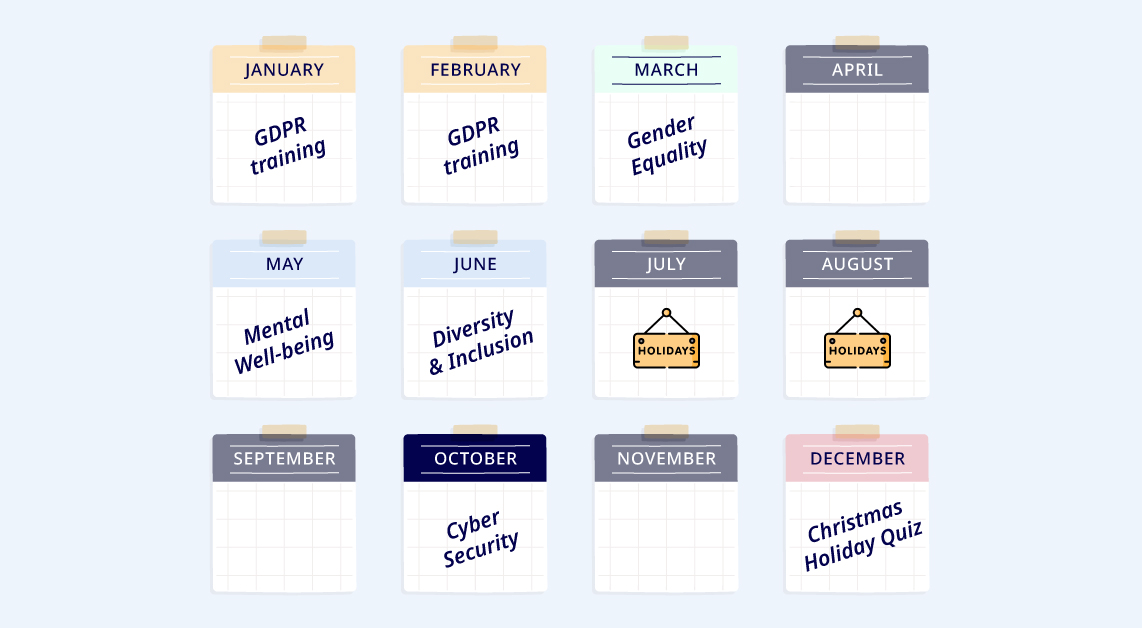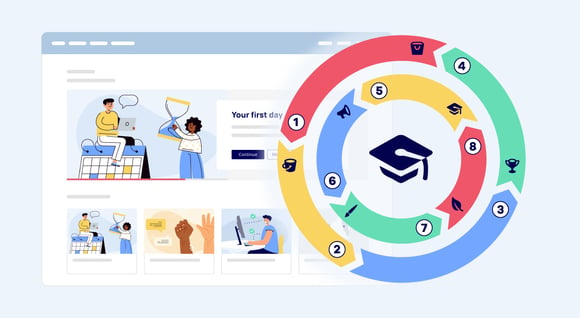Do you find yourself lost in a sea of employee learning and modules? Is it hard to keep track of, update, and manage?
Even if you start out all organized, over time it can get a bit cluttered. Modules and learning paths accumulate, and you might be various admins creating content in the platform. It’s understandable that it’s not always easy to keep the structure when the everyday work comes in between.
Let us help you sort it out and calm down overwhelming feelings. To guide you on this journey, we've compiled a set of insights and tips from our very own People & Development Manager, Cecilie, the one responsible for our internal learning at Learningbank. (And she’s somewhat of an organizing magician!)
Scroll through the list and discover how to keep your learning platform structured and running like a well-oiled machine (Some of the steps might not be relevant for all learning platforms out there, so then just take what fits to yours). Here are Cecilie’s best tips:
Step 1: Create an Overview
In the fast-paced world of employee training, maintaining a clear overview is essential. It's the compass that ensures you're on the right path. So, let's get started and begin with a winter cleaning! (Or perhaps spring cleaning, depending on the season you’re in at this moment.) Here's how:
- Create a comprehensive overview. All through boarding, Excel is a good tool to use here to detail all your learning paths. This will serve as your digital roadmap.
- Once you have this identified, you can begin to delete or archive old and unused learning paths.
- Rename any learning paths if needed. This can sometimes be an easy way to breathe new life into your content.
- Continue by categorizing your content into main themes like "Service", “Sales”, "Well-being" or what other themes you might have and create them as tags in the platform. This will make it easier to find what you are looking for later on, and it will help you when we move on to talk about tags in the next step.
Step 2: The Role of Tags and How to Use them
(If this isn't available in your platform, skip to step 3 below.)
In Learningbank's platform, you can use tags. And tags are your organizing superheroes. They help you streamline your content process and make it easy to find what you are looking for. Go into your platform and:
- Delete all outdated tags.
- Then, create new tags based on your content categorization
- If you’re a global company, make sure to also include target groups, country and department. For example, “Service, SE, Operators”
- Finally, insert these tags into relevant modules and content currently in use.
Step 3: The Importance of Design & Visual Appearance
Visual appeal isn't just a bonus; it's a necessity. For some, the visual and intuitiveness might sound like small things, but the visual part impacts your learning outcomes more than you might think.
Because of this make sure to get this part right. Start by checking these things off the list:
- Do you have a logo for your platform and learning universe? If not, create one and use it consistently, especially in your cover images.
- Craft new cover images in a consistent style. This builds awareness and fosters a sense of belonging to your learning universe.
Ida Borgenvik, HR coordinator at Prima Assistanse, explains the big differences the good visuals & ux design had for their employee engagement and course completion rates:
“Some of the employees had taken the same training in the old platform and had to take it again in the new one. Some of them actually said, ‘Ohh wow, I didn't learn this with the other platform. It's the same text but not in the same way and I didn't understand it in the last platform.”
Step 4: Understand Your Organization's Learner Journeys
For this step, you need to get yourself into the helicopter perspective. Look at your organization from above.
Ask yourself, are the basics under control? Do we have a great preboarding and onboarding set for the entire company? If yes, then the initial learning is set.
Next, you ask yourself whether there is learning that is particularly important for selected departments to learn about – we call it: Department-specific learning. If so, look into whether you should create a simple path for this.
This is when it becomes more detailed. When looking at role-specific learning, ask yourself if there are any roles that need a special introduction to their areas of responsibility. Remember to map it out! Once this is done, you can move on and look at what other learning already exists in the platform and what you need to develop and assign.
By asking the right questions and documenting your findings, slowly, your picture will emerge of the learner journeys for the company as a whole, but also with a focus on departments and individual developments.
Identifying & Connecting Skills to Learning Paths
(Again if, you use another platform than Learningbank and this isn't available in your platform, then skip to step 6.)
Identify which skills are associated with each learning path. Use your Excel sheet from Step 1 for this task to fill it out and get the overview. Then, insert the skills you have identified for each learning path or in your platform.(If you use Learningbank's own platform and want guidance on how to use skills assignments, click on this help center article.)
Tips on How to Incorporate Skills to Your Learning Paths:
- Define Skills Clearly: Start by defining the specific skills that your learning path will help users acquire. Consider skills as a combination of knowledge, abilities, and experience required for a particular role or task.
- Skill Level: Assign skill levels to each skill, indicating whether the training is intended for Novices, Basics, Intermediates, Advanced users, or Experts. Use the 1-5 scale to represent these skill levels, which offers a clear progression for learners.
- Alignment with Learning Objectives: Ensure that the skills you identify align with the learning objectives of your learning path. Each learning objective should contribute to the skill level.
- Create a Clear Learning Journey: Develop a logical learning journey that outlines how users progress from one skill level to another. Ensure the learning paths within the learning journey provide the necessary training and practice opportunities for each skill.
Step 5: Content Planning
Planning content is a necessity for keeping it relevant and structured. A good support for this is to develop a yearly content overview to ensure a consistent and non-spammy user experience. Map out themes, special events, or season-related topics throughout the year. And always remember: Quality always trumps quantity.

Step 6: Create & Share Your Own Playbook
To avoid being back right where you started, in "messy platform land", we recommend you to create your own Playbook. Here, you set the structure and set the rules for how to use and create in your learning platform.
We're telling you, this can become your secret weapon in keeping content creators and administrators aligned and not messing up the structure and order that you now have created. And remember, once it is created, make it accessible and known to everyone administrating or creating in the platform!

